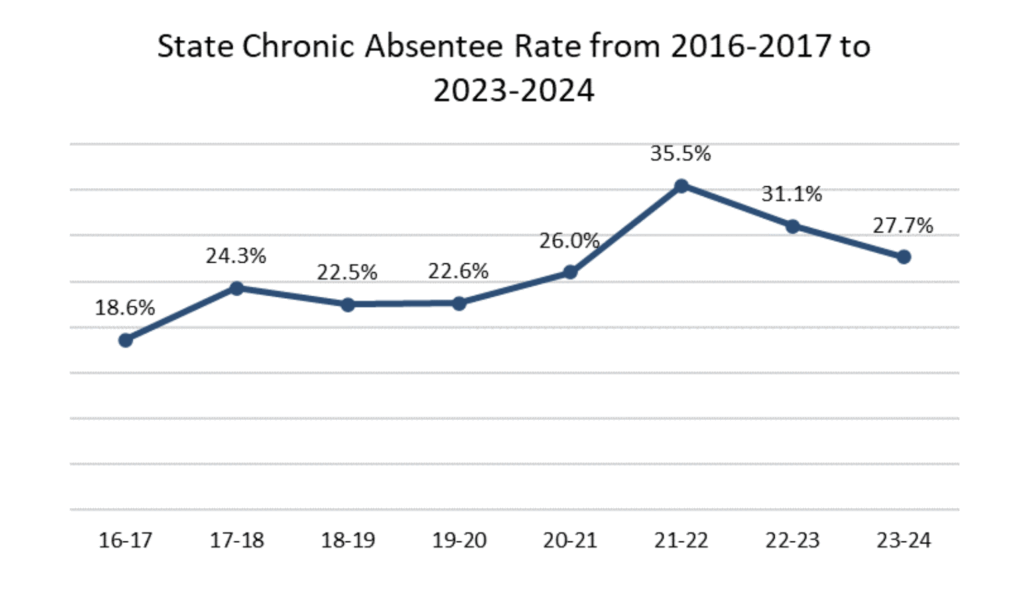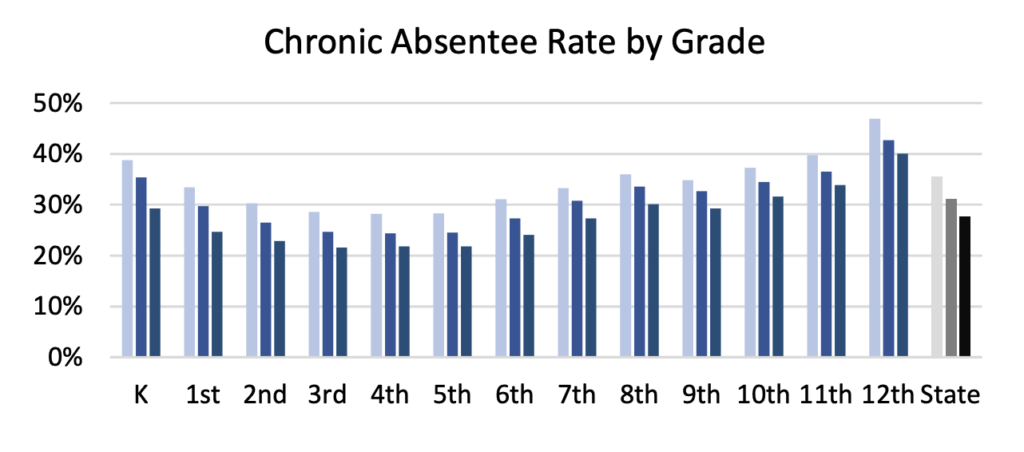A lot of ink has rightly been spilled lately around chronic absenteeism, an increasing challenge for families and schools since the pandemic. Typically, a student is considered chronically absent if they miss 18 days per year, two days per month, or 10% or more of the school year, depending on the state (Chang & Romero, 2008, p. 3). In Colorado, a student absent 10 percent or more of the days enrolled during the school year is considered chronically absent. All absences are included – unexcused and excused.
Nationally, the percentage of chronically absent students rose from 15% in 2019 to 28% in 2022. Although 33 of the 39 states that reported attendance data in 2023 saw reductions in absenteeism, the number of chronically absent students remained nearly 75% higher than pre-pandemic levels. The rise in absenteeism is attributed to a variety of factors, but it impacts students across all racial, ethnic, and socioeconomic backgrounds.
When students miss school frequently, their academic success suffers—particularly in early education, where chronic absenteeism is linked to lower reading proficiency rates in third grade and increased likelihood of dropping out in high school. But the consequences are not limited to academics. Chronic absenteeism can lead to social isolation, increasing the risk of school disengagement and dropout, which in turn is linked to lower lifetime earnings and poorer health outcomes. Additionally, absenteeism can spread among peers; research suggests that when students miss school frequently, it can encourage others to do the same.

(Source: Colorado Department of Education)
In Colorado, absenteeism rates have steadily climbed since 2017, when 17% of students were absent. By 2022, that number had surged to 35%. While absenteeism fell to 31% in 2023, it remained eight percentage points above pre-pandemic levels. A 2024 report by AEI education scholar Nat Malkus, Long COVID for Public Schools: Chronic Absenteeism Before and After the Pandemic, forecasts that even if absenteeism continues to decline at the current pace, pre-pandemic rates won’t be reached until approximately 2030.
Malkus’ updated research, which includes data from eight states in the 2023-2024 school year, shows that Colorado’s absenteeism rate has dropped by another three points to 28% in 2024. Even with a downward trajectory, there are still more than 1 out of every 4 Colorado students who were chronically absent, representing 241,119 students, according to CDE data. Higher rates are seen in the secondary level; more than 30% of 8th, 10th, 11th, and 12th graders were chronically absent in 2023-24.

(Source: Colorado Department of Education)
To combat this trend, three organizations with differing political perspectives – Attendance Works, The Education Trust, and Nat Malkus from the American Enterprise Institute – have united to reduce absenteeism by 50% nationwide over the next five years. The 50% Challenge partners with state leaders to raise public awareness of chronic absenteeism and create resources to help “improve engagement and attendance and address barriers to getting to school.” So far, 14 states have signed on, including Colorado. The initiative encourages states to develop strategies tailored to local challenges and resources.
Rhode Island stands out as a leader in addressing chronic absenteeism. In 2023, Governor McKee pushed for the tracking and publication of student attendance data, making absenteeism a focal point of public discussion. The state’s data dashboard, which updates daily attendance figures, revealed alarming numbers, even in districts that were previously considered successful. Factors contributing to absenteeism are varied, but one key challenge has been the post-COVID mindset, with many students and families believing that school attendance is less important.
Governor McKee has taken a collaborative approach, bringing together stakeholders from education, government, healthcare, and business to tackle absenteeism. Through the LEARN365 initiative, Rhode Island has implemented concrete actions. For example, the Secretary of Commerce encouraged businesses to support school attendance by limiting high school students’ work hours and offering scholarships for consistent attendance. Hospitals like Hasbro Children’s Hospital have educated parents through discharge videos, and companies back the AttendanceMattersRI campaign to emphasize the importance of showing up for school. While the results have not been immediate, absenteeism in Rhode Island has dropped by 10 percentage points since the 2021-22 school year. Though the path back to normal attendance will be long, Rhode Island’s efforts show that a community-wide approach can make a meaningful difference.
For its part in the 50% Challenge, the Colorado Department of Education created the Every School Day Matters campaign. This campaign takes a practical and community-driven approach by empowering schools, families, and local partners to take responsibility for getting kids back in class The initiative provides tools like bilingual attendance calendars, communication templates, and health-related guidance. Community partners also play a key role by offering transportation assistance, incentives, and flexible work arrangements for parents. So far 43 school districts and 34 schools across the state have signed up for the campaign.
Addressing chronic absenteeism requires a unified effort from educators, policymakers, businesses, and communities to keep students in the classroom. While initiatives like LEARN365 and the national 50% Challenge demonstrate promising progress, absenteeism rates in many areas remain higher than pre-pandemic levels, threatening long-term student success. Without sustained public awareness, policy-driven interventions, and community engagement, absenteeism risks becoming normalized. The road ahead demands a focused, data-driven commitment to reversing this trend and ensuring every student has the support needed to attend and thrive in school.
Sources:
Hedy N. Chang and Mariajosé Romero, Present, Engaged, and Accounted For: The Critical Importance of Addressing Chronic Absence in the Early Grades, National Center for Children in Poverty, September 2008, https://www.nccp.org/wp-content/ uploads/2008/09/text_837.pdf
Gottfried, M. A., Kirksey, J. J., & Ozuna, C. S. (2020). Exploring the Links Between Student and Classmate Chronic Absenteeism. Teachers College Record, 122(12), 1-28. https://doi.org/10.1177/016146812012201205 (Original work published 2020)
Colorado Department of Education. (2024). Summary of 2023-24 Attendance Data Release. https://www.cde.state.co.us/dropoutprevention/attendancesummary2022-23
Cohen, L. (2024, August 22). Team sport: Rhode Island’s statewide strategy for reducing chronic absenteeism. FutureEd. https://www.future-ed.org/team-sport-rhode-islands-statewide-strategy-for-reducing-chronic-absenteeism/?mc_cid=29b8148d31&mc_eid=61405f0f10



